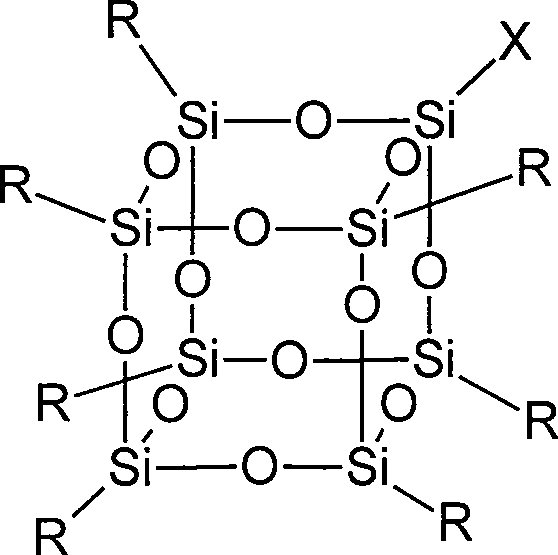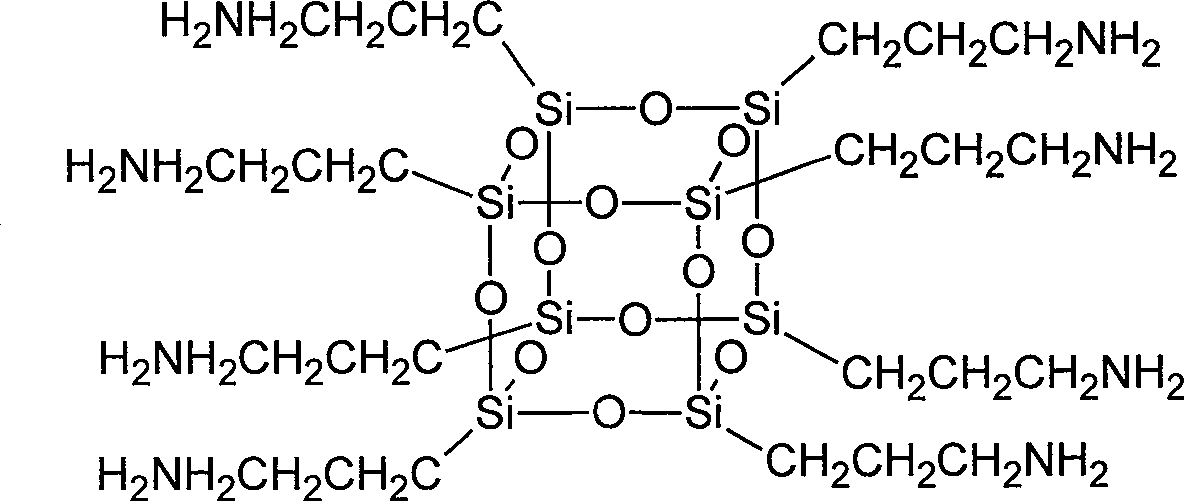Synthesis method of multi-amino polyhedral oligomeric silsesquioxanes
A technology of silsesquioxane and polysilsesquioxane, which is applied in the direction of silicon organic compounds, can solve the problems of restricting the research, promotion and application of POSS compounds, complex separation and purification process, and high synthesis cost, and achieve a single product structure Good performance, simple process and short reaction time
- Summary
- Abstract
- Description
- Claims
- Application Information
AI Technical Summary
Problems solved by technology
Method used
Image
Examples
Embodiment 1
[0018] Place a 500ml three-necked flask in a constant temperature water bath at 50°C, first add 90g (5mol) of deionized water, 40ml of ethanol, 10ml of acetonitrile, 10ml (about 0.1mol) of triethylamine and 2ml of tetramethylammonium hydroxide to the three-necked flask in sequence , stirring at medium speed to make it evenly mixed. Then, 221 g (1 mol) of γ-aminopropyltriethoxysilane was added dropwise to the mixed solution, and stirred at reflux at constant temperature for 18 hours at 50°C. The solvent was removed under vacuum at room temperature to obtain the crude product as light yellow powder. The crude product was first washed with 1000 ml of deionized water for 3 times, then washed with acetone, and vacuum-dried to obtain a white powdery final product with a yield of 92.0%. Its molecular structural formula is as follows:
[0019]
Embodiment 2
[0021] Place a 1000ml three-necked flask in a constant temperature water bath at 80°C, first add 180g (10mol) of deionized water, 80ml of ethanol, 20ml of acetonitrile, 20ml (about 0.2mol) of triethylamine and 5ml of tetraethylammonium hydroxide into the three-necked flask in sequence , stirring at medium speed to make it evenly mixed. Then, 221 g (1 mol) of γ-aminopropyltriethoxysilane was added dropwise to the mixed solution, and stirred at 80° C. for 18 h at constant temperature under reflux. The solvent was removed under vacuum at room temperature to obtain the crude product as light yellow powder. The crude product was first washed 3 times with 1000 ml of deionized water, then washed with acetone, and vacuum-dried to obtain a white powdery final product. Yield 90.5%.
Embodiment 3
[0023] Put a 1000ml three-necked flask in a constant temperature water bath at 70°C, first add 180g (10mol) of deionized water, 60ml of ethanol, 30ml of propionitrile mixed solvent, 30ml (about 0.3mol) of trimethylamine, and 3ml of tetramethylammonium hydroxide to the three-necked flask in sequence Mix at medium speed to combine evenly. Then, 221 g (1 mol) of γ-aminopropyltriethoxysilane was added dropwise into the mixed solution, and stirred under constant temperature reflux at 70° C. for 18 h. The solvent was removed under vacuum at room temperature to obtain the crude product as light yellow powder. The crude product was first washed with 1000 ml of deionized water for 3 times, then washed with acetone, and vacuum-dried to obtain a white powdery final product with a yield of 93.0%.
PUM
 Login to View More
Login to View More Abstract
Description
Claims
Application Information
 Login to View More
Login to View More - R&D
- Intellectual Property
- Life Sciences
- Materials
- Tech Scout
- Unparalleled Data Quality
- Higher Quality Content
- 60% Fewer Hallucinations
Browse by: Latest US Patents, China's latest patents, Technical Efficacy Thesaurus, Application Domain, Technology Topic, Popular Technical Reports.
© 2025 PatSnap. All rights reserved.Legal|Privacy policy|Modern Slavery Act Transparency Statement|Sitemap|About US| Contact US: help@patsnap.com



